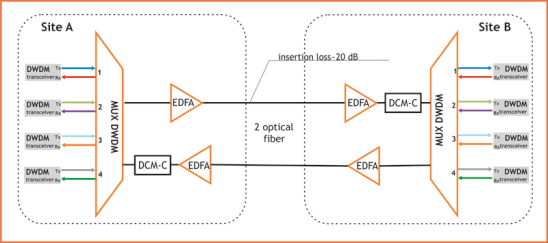DWDW is short for dense wavelength division multiplexing. It’s a technology for transmitting multiple signals simultaneously at different wavelengths on the same fiber. It can save a lot of optical fiber resources in long distance transmission applications.
DWDM can be divided into passive DWDM system and active DWDM system.

Passive DWDM system
Active devices such as optical fiber amplifiers and dispersion compensators are not used in passive DWDM systems. The transmission distance of this system is limited by the transmit power of the optical transceiver, but it has the advantages of high channel capacity, and is mainly used in the high speed transmission lines of metropolitan area network and high channel capacity.

Active DWDM system
Active DWDM is a system that contains transponders, the function of the transponder is optical electro optical (OEO) conversion. The management and maintenance of active DWDM system is also more complex, so its operation cost is higher. Active DWDM systems are still widely used in large capacity optical transmission applications.

Both passive DWDM and active DWDM have their own pros and cons, which will be described in detail below.
Pros and Cons of Passive DWDM
Cost savings: Compared with the active DWDM backbone network configured with fiber amplifier and dispersion compensator, passive DWDM can construct high-speed transmission line with high channel capacity at lower cost.
Easy to use: passive DWDM is a plug and play system, which is simple and convenient to use.
Even though passive DWDM has the two main benefits, it still has the drawback.
Scalability: Passive DWDM systems have limited number of wavelength channels, if want to expand the network, we must use more passive DWDM devices, which will increase the management difficulty of the system.
Pros and Cons of Active DWDM
Active DWDM systems support a larger number of wavelength channels. Therefore, the bandwidth is greater and the utilization ratio of optical fiber is higher.
Active DWDM system is easier to manage, and users can tune the channel wavelength without shutting down the system, and the expansion of the active DWDM system is simpler.
The transmission distance of the active DWDM system is longer than the passive DWDM system, and the deployment cost is higher.
Active DWDM systems also use fiber amplifiers, dispersion compensators and other devices, and the deployment is more complex than passive DWDM systems.
Both passive DWDM systems and active DWDM systems have advantages, and we should deploy appropriate DWDM systems according to specific application requirements.
HTF provides a range of DWDM solutions to help you achieve fiber expansion in an economically efficient way. For more details, welcome to contact our sales: sales6@htfuture.com.





没有评论:
发表评论